There are tremendous benefits to investing in high quality governance, risk and compliance software. Appropriate software programs are one component of a systematic and effective approach to creating and maintaining a healthy, secure and productive business environment. Collecting appropriate data is important, and analyzing that data to create healthy and achievable goals for improvement can be overwhelming without appropriate software to produce data sets and metrics that are meaningful and useful for goal setting, future planning and regulation compliance.
What Does “Governance, Risk and Compliance Software” Mean?
Governance, risk and compliance software means a software package specifically designed to manage data collected about corporate compliance to business regulations and laws, including health and safety regulations. These software packages turn data into meaningful reports that can be analyzed and shared with all stakeholders. They also assist in creating actionable goals for increasing compliance with laws and regulations. Governance, risk and compliance software is one important business tool that can help mitigate risk, and prevent potential challenges from developing into crisis.
Key Benefits of Investing In Governance, Risk and Compliance Software
- Create and maintain a healthy, secure environment. Mitigate risk and manage crisis
- Confidently meet regulated objectives and comply with legal mandates
- Be proactive, not reactive. Identify risks and potential problems sooner
- Manage large amounts of data with ease
- Share meaningful data across many teams easily
- Produce reports instantly
- Improve production rates, improve product quality and increase profit
Drawbacks And Limitations To Using Governance, Risk and Compliance Software
The benefits of including Governance, Risk and Compliance software in your overall approach to management far outweigh the drawbacks and limitations. Having many tools to create healthy environments is best practice for forward planning. There are a few things to keep in mind to be certain that you get the best results from your governance, risk and compliance software
- There are many governance, risk and compliance software packages available. Choosing the software package that is most appropriate for your unique needs makes a tremendous difference! Do your research
- The accuracy of the data entered affects the meaning of the metrics generated by the software. Appropriate and accurate data collection and data entry are essential
- Remember that governance, risk and compliance software results are always most effective when used not as a sole indicator, but as one of many components of a healthy business model. Using many different methods of environmental management and security, and cross checking results in several different ways to confirm authentic results, are the surest methods for achieving goals and to successful management overall
LOGICMANAGER
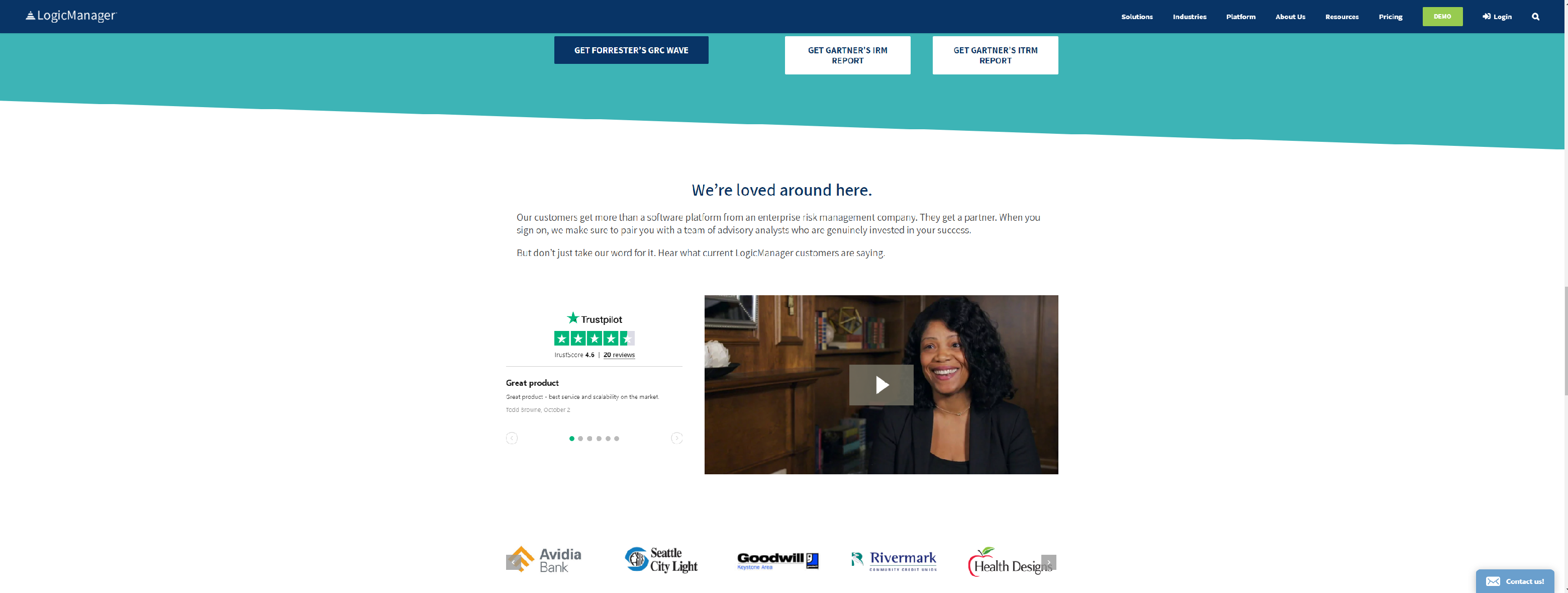
LogicManager Leading GRC Software Merges Cost Effective Innovation, Industry Expertise, and Customer Satisfaction. Improve Performance with Integrated GRC Solutions.
- Enterprise Risk Management
- Incident Management
- IT Governance & Security
- Compliance Management
- Vendor Management
- Financial Reporting
- Audit Management
- Business Continuity & DR
- Policy Management
BWISE
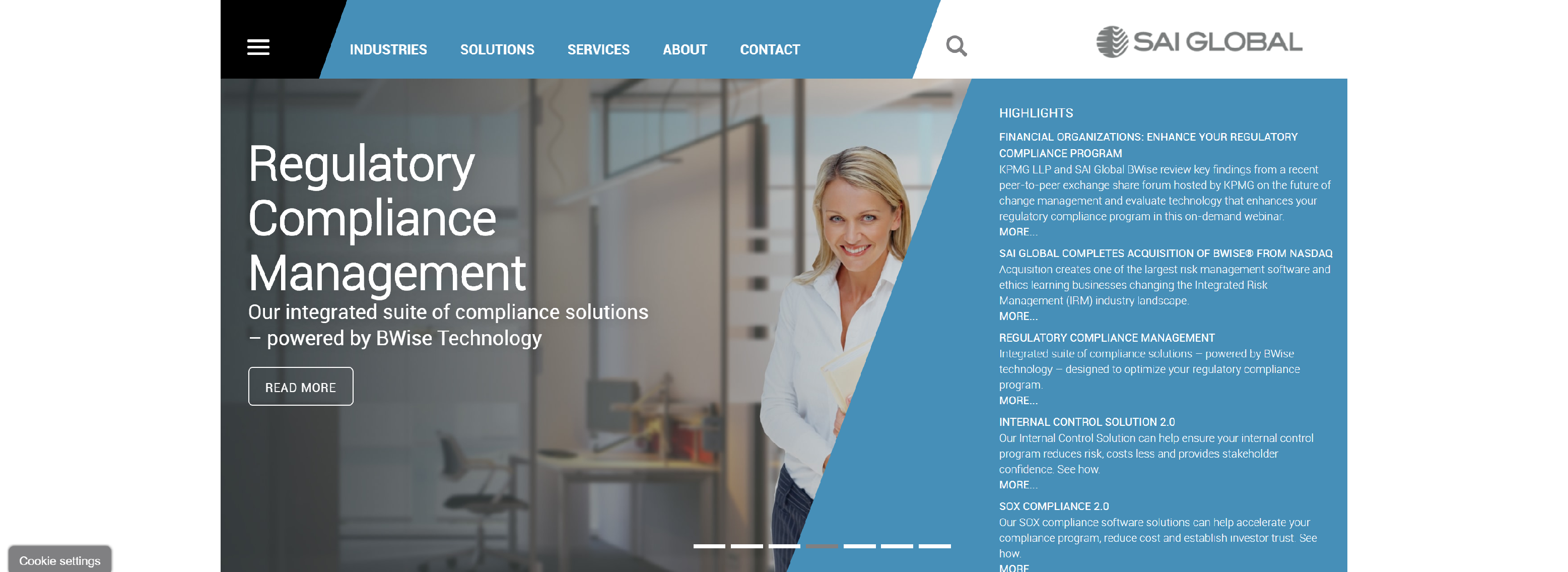
BWise Governance, Risk Management and Compliance software enables organizations to be in control of all of their key financial and reputational risks.
- Corporate Governance
- Financial Governance
- IT Governance
- Regulatory Change Management
- Global Data Protection Regulation (GDPR)
- Sarbanes-Oxley (SOX) Compliance
- Operational Risk Management
- Enterprise Risk Management
- Quantitative Risk Management
- Vendor Risk Management
- Audit Analytics
- Information Security Management
- Segregation of Duties
- Continuous Controls Monitoring
METRICSTREAM

MetricStream provides Governance, Risk and Compliance (GRC) software solutions that allow companies across various industries to streamline and automate their enterprise-wide GRC programs.
- Enterprise Risk Management
- Operational Risk Management
- Compliance Management
- IT Risk Management
- Third-Party Management
- Internal Audit Management
LOGICGATE
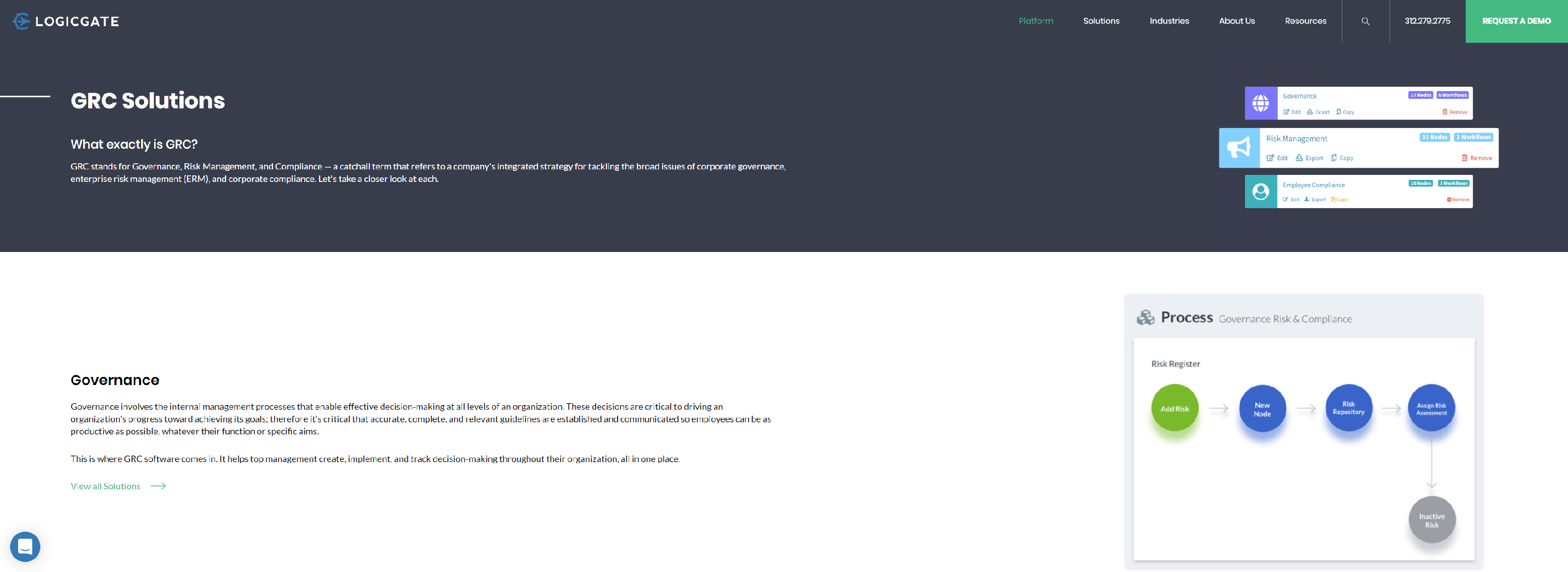
The LogicGate platform empowers businesses to build agile enterprise process applications that deliver workflow automation and process efficiency.
- Enterprise Risk Management
- Third-Party Risk Management
- IT Security Risk
- Compliance Management
- Policy Management
- Incident Management
- GDPR Compliance
- Audit and Controls Management
- Business Continuity Management
QUANTIVATE
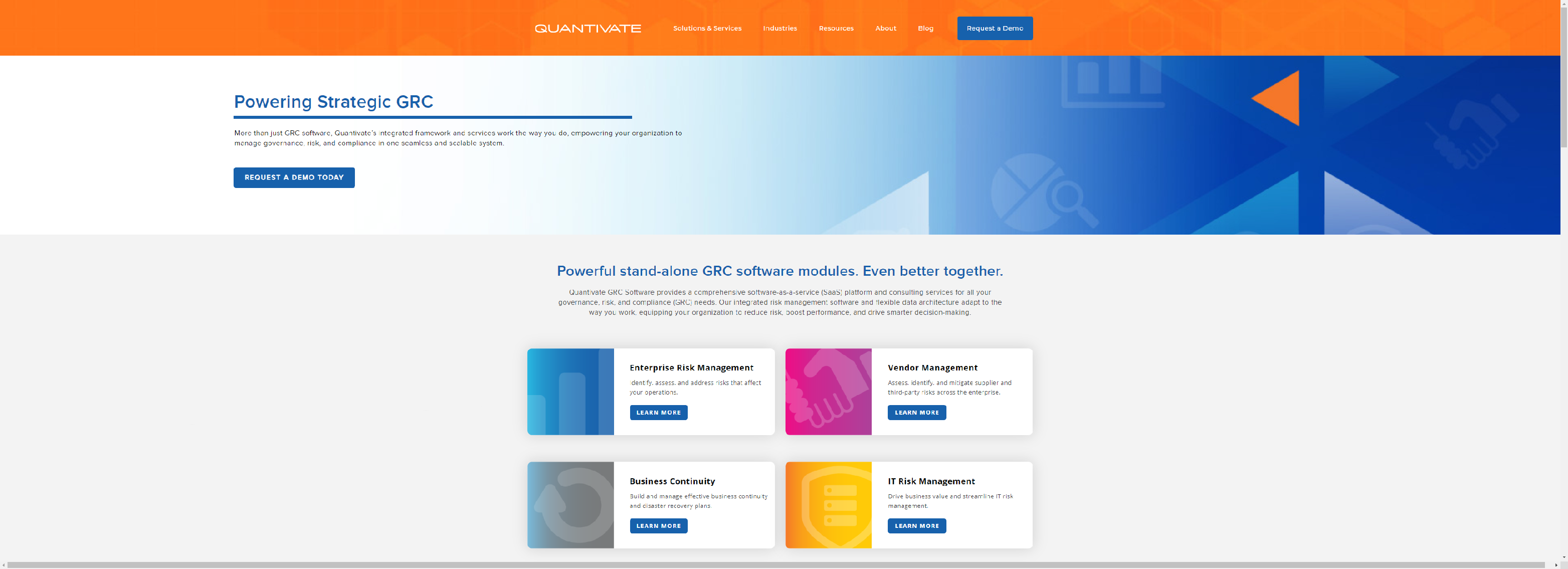
Quantivate’s Governance, Risk, and Compliance (GRC) software solution enables you to effectively and efficiently manage your compliance, risks, and governance initiatives across the enterprise.
- Enterprise Risk Management
- Vendor Management
- Business Continuity
- IT Risk Management
- Compliance Management
- Internal Audit
- Complaint Management
- Policy Management
CURASOFTWARE
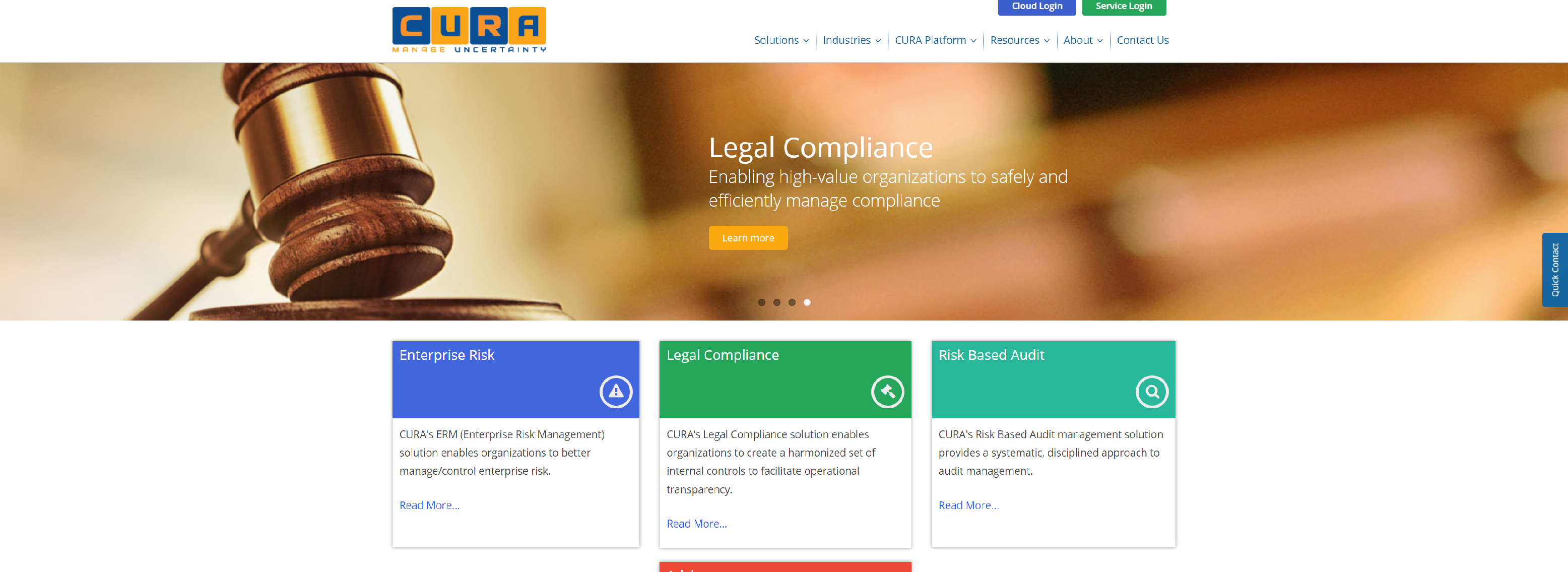
CURA Software Solutions provides powerful GRC solutions are backed by a worldwide team of subject matter experts & more than ten years of implementation expertise at leading organizations.
- Enterprise Risk
- Legal Compliance
- Risk Based Audit
- Advisory
- Operational Risk
- Incident Management
- Business Continuity
ICOMPLIANCE

Discover Integrity Compliance here: the leader in compliance services in Melbourne for businesses in the financial services industry and AFS Licensees.
- Help AFSLs streamline the governance, risk and compliance processes
- Take business-critical tasks out of spreadsheets, shared drives and email and place them into an auditable and secure system
- Give AFSLs transparency in the management of their regulatory obligations
- Translate regulatory jargon into simple tasks that help AFLSs reduce their regulatory risk
WEGALVANIZE
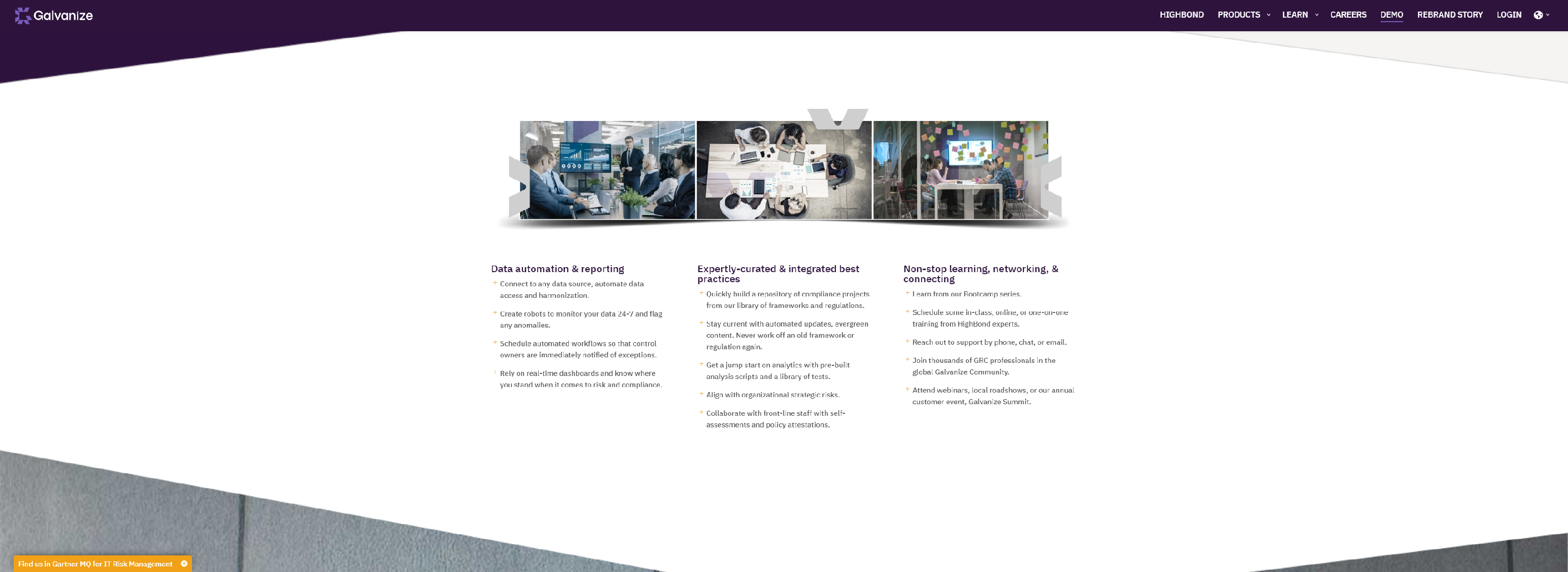
Galvanize builds security, risk management, compliance, and audit software. We’re on a mission to unite these teams in our HighBond platform in order to strengthen individuals and protect organizations.
- Get the answers that drive strategic change
- Rally everyone around a single source of truth
- Lean on industry best practices and expert design
- Focus on professional development and growth
ONSPRING

Onspring is a no-code platform for process automation, workflow, collaboration and reporting.
- Audit Management Software
- Contract Management Software
- Controls & Compliance Software
- Vendor Management Software
- Risk Management Software
- Business Continuity Software
STANDARDFUSION
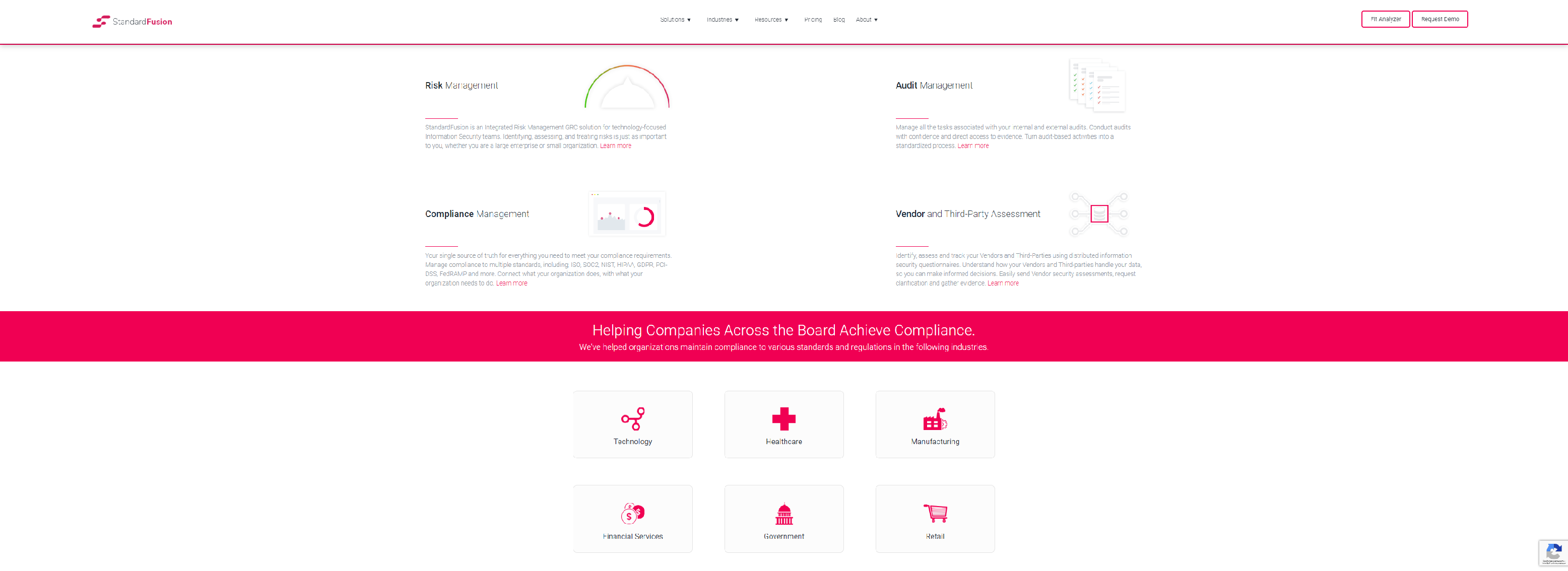
Integrated Risk Management GRC Software that fixes the way you manage your risk and compliance.
- Risk Management
- Audit Management
- Compliance Management
- Vendor and Third-Party Assessment
What is Integrated Governance, Risk and Compliance?
Business entities continually face challenges from emergent demands to drive superior quality, guarantee information security and maintain value-driven performance. The need to create a credible name has led to a broad diversity of interventions in conforming to strict information security measures.
While the conventional business environment dealt with governance, risk and compliance as separate entities without fusion focus; modern organizations are now breaking away from the isolated efforts in integrated governance, risk and compliance to effectively manage security and growing costs.
Organizations are now realizing that there is a greater need for an integrated compliance framework that can deal with all compliance issues in an incorporated and seamless manner. This approach assists entities to manage all facets of governance risk and compliance in a centralized fashion so as to promote greater accountability and transparency.
An integrated governance, risk and compliance framework is the perfect solution that reduces costs, creates more revenue and generates more value as well as providing a competitive edge to organizations. These solutions are effortlessly deployed for all management purposes with context-based inference engines, easy logging in and monitoring solutions and advanced alert processing.
While many GRC vendors and professionals differ when it comes to a standard definition for integrated Governance, Risk and Compliance; a survey conducted by GRC professionals resulted in this widely-accepted definition:
” Governance, Risk and Compliance or GRC for short is an integrated, holistic approach to organization-wide governance, risk and compliance ensuring that an organization acts ethically correct and in accordance with its risk appetite, internal policies and external regulations through the alignment of strategy, processes, technology and people, thereby improving efficiency and effectiveness.”
Specifically, the three pillars of governance, risk and compliance are:
Governance:
This is the effective, ethical management of a company by its managerial levels and executives.
Risk:
This is the ability to successfully and cost-efficiently alleviate risks that can deter an organization’s operations or capacity to remain competitive in the market.
Compliance:
This is a company’s accordance with authority requirements for data retention, business operations among other business practices.
GRC business policies, services and solutions enable organizations to execute, manage, check and measure the efficiency of their integrated Governance, Risk and Compliance strategies. Governance, Risk and Compliance strategies rely on distinct objectives that provide entities with insight into the overall success in each area of governance, risk and compliance.
Given that GRC policies spin the whole organization, these tools and strategies require proper management and coordination across numerous departments in an organization including management, IT, compliance, auditing and security.
Tips for Implementing Governance, Risk and Compliance
The implementation of governance risk and compliance will assist in the automation the collection, correlation and reporting of information to offer a broader picture of how well the company is not only performing, but also how well it is complying with the law and managing risk. Implementing GRC within your organization takes some planning and with a few tips, you can be well on your way to making the successful changes you need.
- The Learning Curve. You have your plan laid out and it’s a done deal. Remember, nothing is perfect. You will need to make changes for the different individuals you will work with, serve and deal with on any level.
- Team work makes the best plans. If you compile your team from a variety of departments throughout your organization, you are more than likely to create a sound plan, employees that are on board and supportive of the plan and less likely to duplicate any work.
- Before committing to the plan or a specific program, ensure that upper management is aware and on-board with the amount of time that must be devoted to not only learning the product but also utilizing the system. It is not a small feat and does require an extensive amount of training.
- Start small in a large organization. Pilot a program in one or two areas to test the possibility of success and commitment before attempting to roll it out over an entire organization at once.
- Do not buy the program and expect it to magically work right out of the box. You must develop the framework and mindset within the organization beforehand. If you are not successful in this area, the roll out and implantation will be an utter failure.
- “When I describe this to a client, I usually say if you break GRC down, governance is how you make decisions, risk is how you prioritize your decisions based on how risky something is and compliance is how you address various mandates, be they external or internal,” Proctor says. If you organization can not relate to this make-up and get excited about the possibilities, you either have a substantial amount of work ahead of you and are not ready for this car or it’s time to plug the plug and call the project an well-deserved attempt.
Taking on and implementing any new program in a company can be a risky, stay true to the overall desire for success but remain open for the potential for failure. It is okay to admit defeat sometimes.
What is ISO 19600:2014?
Compliance issues hurt businesses every day and can cost a company millions of dollars in fines. If you’ve heard about ISO 19600:2014 and you’re wondering how it relates to your establishment, this article will walk you through the definition, origin and its role in the workplace.
ISO 19600:2014 Definition and Origin
ISO 19600:2014 is the new international standard. Under the International Organization for Standardization (ISO) in the workplace, ISO 19600 which originated in Australia and was developed by a committee as the Australian Standard for Compliance, or AS 3806:2006.
Compliance is about adhering to policies and laws to minimize risk and fines. ISO 19600 serves the purpose of helping organizations with their compliance management system. The emphasis of ISO 19600 is to ensure the compliance culture is embedded in an organization and integrated in every aspect of the flow and function of various departments as it relates to governance risk and compliance.
New ISO 19600 Standards Increase Compliance and Cut Costs
Martin Tolar, who chairs the ISO project committee, confirms that ISO 19600 is “expected to serve as a global benchmark for compliance officers, businesses, commentators, academics – and regulators.”
ISO 19600 has seven fundamental standards to ensure function and support of a compliance management system in the workplace. These are: leadership, planning, operation, and support, the context of the company, performance evaluations and areas to improve upon.
The role of the compliance management system is to ensure that policies and objectives are established and adhered to. It also seeks out ways to implement these objectives.
Governance Risk and Compliance
Many workplace organizations think that the role of legal and regulatory obligations only resides with their compliance department. Where ISO 19600 comes in is it clearly defines that compliance is more expansive and obligations should be included in the standard operating procedures. Key areas to focus on include:
- Legal and regulatory compliance
- Organizational compliance from policies and procedures
- Contractual compliance
Improving Processes with Governance, Risk and Compliance
Governance, Risk Management and compliance (GRC) is a combination of processes that work together to ensure that an organization meets its objectives. Governance describes the oversight role where the senior executives plan, direct and control the whole organization. Risk management helps organizations to identify and evaluate all business and regulatory risks and put in measures to mitigate them effectively. Risks should be managed effectively in order to stay in business. Compliance on the other hand refers to the state of conforming to the requirements. It ensures that an organization puts in place internal controls and processes to meet the stated requirements imposed by various regulatory bodies or internal policies. GRC therefore emphasizes on the ability to achieve the goals of an organization while addressing all uncertainties and working with integrity.
Governance, Risk and Compliance help your company improve its internal processes in a number of ways. Key among them includes:
It provides an increased clarity of roles, responsibilities and boundaries between the Board and Management. Due to the increased sharing of information, the management is able to understand and execute their duties well.
GRC ensures that various processes meet the necessary regulatory requirements that are established. Adopting a GRC strategy will define the entire organization structure in a manner that everyone makes risk and compliance their business.
It leads to a reduced overall risk and increased overall compliance. A strong GRC solution enables an organization to have more risk awareness, giving it an opportunity to put in place strategic plans to help in the mitigation of the risks. More so, your organization is likely to be able to make compliance sustainable in an ongoing basis and at a lower cost.
Integrating Governance, Risk and Compliance reduces the potential duplication of work and waste of resources. It eliminates a situation where a compliance officer is managing compliance risks and a risk management officer is also having compliance risks under their management leading to duplication of work. This will therefore reduce overlap of tasks and wastage of resources in your organization.
Adopting a GRC strategy will ensure that critical information in the risk and compliance operations is shared with the decision makers in a timely manner hence ensuring that risk and compliance roles are included in the strategic decision making meeting. Thus, your organization is able to make right decisions and take advantage of opportunities.
Steering Clear of Workplace Risk
Governance risk and compliance, or GRC, is the system of using governance, risk management, and compliance to ensure that a business or organization meets safety standards and meets its objectives. One such way of maintaining governance risk and compliance is making sure all employers and employees understand the importance of workplace safety — and with injury at work being one of the top causes of injury, it is easy to see why GRC is so crucial.
Communicate Safety Regulation and Policy
It’s required of every business to have a safety policy, but some business could do a little better about making it easily available and accessible. Post the policy on bulletin and notice boards, include them in every handbook, and perhaps even consider conducting monthly sessions with employees to ensure that they are up to date.
Invite Suggestion
Reach out and consult with staff – have a suggestion box or another easy to reach system where employees can talk about their own ideas. This will not only open opportunities for smart ideas, but will provide a more comfortable workplace where the staff feels like they are heard about important issues such as safety.
Maintain Cleanliness, Organization, and Comfort
There are a number of simple, easy, and fast solutions for many of the common causes for injury – loose cables across the floor, rips in the carpet or floor, or narrow steps on a staircase – that should always be taken advantage of. Make sure avoidable entanglements are actually avoided (for example, properly organizing cables) and promptly deal with any potential hazards.
In addition to smart organization, providing basics, such as clean and working toilets, drinking water, and adequate lighting, should be an obvious endeavor — but don’t forget tools to help, too.
A common mistake many businesses make is buying cheaper chairs or desks to try and save some money. This is not actually smart economics when these cheap chairs will result in back problems for half of your employees. Go for the high quality, long lasting equipment, and your staff – and your budget – will thank you.
Signage and Verbiage
Despite our best efforts, some hazards can’t be immediately avoided, and in these situations proper signage is crucial. Among the many different scenarios: any spills should be marked with “Wet Floor” signs, uneven or unstable deviations in flooring should be marked, lose or wobbly hand rails, etc. Being aware of potential dangers will help everyone.
Benefits of a GRC Plan
If you are in a compliance profession, one of the challenges that you are probably likely to face is to explain governance, risk, and compliance. That can result into bold financial and operational benefits to a business entity. It is advisable to verify the latter to see how GRC can create an environment where critical points are helpful in order to encourage decision making. To many, this challenge could result in a push to refer to the common provisions of the both regulatory and legal requirements. In order for a business to have an effective compliance plan, this is a major recommendation that the management team needs to reinforce. It echoes the notion that a company ought to affect certain measures as enshrined in the regulations failure to which will lead to the imposition of certain penalties. Such fines and consequences will eventually translate into reputational harm.
Ability to function in an efficient, productive environment where all elements operate harmoniously towards a common goal of ensuring compliance is one of the major benefits of a governance, risk and compliance plan. There are also other additional benefits that come with the positive activity of monitoring and gauging the performance benefits accrued due to an integrated approach to GRC. As a compliance personnel, your responsibility should be to assist management in formulating a crucial connection that exists between a strong compliance process and a required business result that could be felt in a broad range of areas. Some of these areas may include:
- Good reputation coupled with a brand protection. Proper risk management enhances the reputation of a company
- Consumer acquisition and retention. This comes as a result of improved effectiveness in production and management
- A motivated and improved workforce
- Surging profits that come from process optimization
- Asset protection. Improved effectiveness would also mean a better supervision of company assets.
- Lower production cost
- Revenue enhancement
- High-quality information. Management is in a better position to make many intelligent decisions when governance, risk, and compliance information are integrated.
In essence, having a governance, risk and compliance plan for your business will bring benefits such as operational efficiency along with many others.
Creating a Strategic GRC Plan
A Governance, risk and compliance strategy (GRC) is vital for every company whether big or small. GRC entails ensuring that a company develops a culture of practicing sound governance, managing risks, and complying with regulations. It is also concerned with whether the company effectively communicates its ethics, procedures and policies to its employees. A company that implements GRC principles should also ensure that its values are known within and without the business and that compliance has a positive impact on its performance, objectives and strategies.
As a result, the company can have a more cohesive board of directors and help its employees think critically and strategically. It will also oversee IT strategy and IT governance. GRC also makes strategy sustainable, practical and operational while providing direction and pace to both the employees and the management. It also enhances security and safety in the company as well as provides checks and balances necessary for monitoring and coordinating the company’s projects to ensure that they are running smoothly. GRC also focuses more on risks hence it minimizes conflicts and disagreements. With all these benefits, it is important to know how you can create a cohesive and productive GRC plan. Here are the simple steps to follow:
1. Identify the different problems, and processes: research widely and acquire as much knowledge as you can lay your hands on about the GRC processes, requirements, and technology. Also evaluate and classify the number of methodologies, processes, frameworks and technologies used in managing risks and enabling compliance throughout your business operations. That will be your starting point in revolutionizing the way you run your organization.
2. Identify the objectives and goals that you want the GRC strategy to achieve: begin this exercise of setting goals by formulating a mission and vision statement for the GRC strategy that you intend to implement. In the process, you should also come up with a program structure for your GRC strategy that should include federated, centralized or intentional but unplanned cooperation. The structure will influence many other goals especially the systematic usage of technology.
3. Draft a short term plan for meeting the GRC requirements: once you have set clear goals of your GRC plan, you can identify the indicators of your GRC’s success. Consider including the improvements that will be linked directly to the company’s profits and accelerate the adoption of the strategy by all employees across the departments. The plan should cover a short period of maximum one year.
4. Carry out a thorough risk assessment exercise in your company: conduct a comprehensive risk analysis for your organization and use the findings to understand, control and monitor the risks better.
5. Create a comprehensive and a practical action plan: use the short-term plan as a drawing board and ingredient for a more comprehensive strategic plan. The final action plan should incorporate all the facets of an effective GRC plan for the long term implementation in the company.
Getting Certified in Governance, Risk and Compliance
In a technology-infused business environment it can be challenging to maintain an attentive eye on all of the organizational and security components of your company. Governance risk and compliance is a term that used by organizations to represent the integrated approach to making sure that a company meets its business objectives. Governance deals with how a company is structured and managed, Risk management helps business leaders to predict and deal with organizational obstacles, and compliance handles how employees and the governing body follows the company’s policies and procedures.
Governance Risk and Compliance Certification
It has become increasingly important for companies to implement control mechanisms to ensure their business runs smoothly. There are typically different areas of GRC, including those for the Financial, Information Technology and Legal departments.
Certification in Governance Risk and Compliance is a way to prove that you are competent in one or more of the subject areas. Prospective students can choose one component of GRC such as risk management or complete coursework in all three subjects and receive certification in GRC.
GRC Schools
The most widely recognized organization offering certification in governance risk and compliance is the Open Compliance and Ethics Group (OCEG). This non-profit agency offers free resources and seminars related to GRC and also offers a certification program at four different levels.
Through the completion of hands-on courses, professional seminars and a comprehensive exam, you can become certified in governance risk and compliance or any of its sub-disciplines. There is not a national regulations committee for the field as of yet, but OCEG’s 40,000 members, which include Dell and Wal-Mart, make it the leading authority on GRC certification.
Why Should I Get Certified in Governance Risk and Compliance?
Why should you spend the time and money to complete a certification program in governance risk and compliance?
- Certified employees often make more than their counterparts, up to 40% more by some studies
- You have verifiable proof that you have extensive knowledge in governance risk and compliance
- You can add the credential to your resume
- You ensure that you will continue to learn about GRC principles as continued education and re-certification is required to stay in good standing
- You will have more confidence knowing that you understand the GRC Capability Model that is in the OCEG Red Book